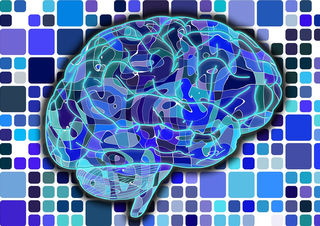Artificial Intelligence
New AI System May Help Chemo Patients
Scientists apply AI for network analysis of cancer symptoms.
Posted March 6, 2019

In a recent scientific first, researchers from the University of California and the University of Surrey deployed network analysis (NA) using artificial intelligence (AI) to provide insights on the unrelieved symptoms that cancer patients who undergo chemotherapy treatment experience.
According to the researchers, this study is “the first to use NA methods to examine the relationships among 38 common symptoms in a large sample of oncology patients undergoing CTX using ratings of occurrence, severity, and distress.” (CTX is an acronym for chemotherapy.)
Network analysis is a methodology used to analyze and optimize elements in a network that have a connection. NA is used in research for depression, post-traumatic stress, complex bereavement, systems biology, and more applications.
In a study published a few weeks ago in Scientific Reports, researchers used network analysis on a database of the common symptoms of cancer patients in chemotherapy treatment.
In this research study, the common symptoms of 1,328 cancer patients undergoing chemotherapy were grouped under three key networks: occurrence, severity, and distress. The researchers used two separate models of Pairwise Markov Random Fields (PMRF) for the analysis. One model used the IsingFit R-package—a binary equivalent of the Gaussian approximation method—for the symptoms in the occurrence data. For the severity and distress data, a different model with the R-package qgraph was deployed. The researchers used the polychoric correlation method with the glasso algorithm.
The study resulted in the discovery that nausea, a common symptom, had the highest scores for all three centrality indices in the occurrence network with 47.48% of patients reporting the symptom before their next chemo treatment. The symptom of lack of appetite, reported by 41.31% of the patients in the study, had the highest scores for all three centrality indices for the severity and distress networks, as well as the second highest centrality score in the occurrence network. The research team stated in their report that “these symptoms may be targets for therapeutic interventions that if successful would reduce other symptoms in the network.”
According to the researchers, “This study provides the first direct evidence that the connections between and among symptoms differ depending on the symptom dimension used to create the network,” and the findings “can be used to guide the development of symptom management interventions based on the identification of core symptoms and symptom clusters within a network.”
Despite modern breakthroughs in immunotherapy, chemotherapy remains the common treatment for many cancers. Chemotherapy is the use of any drug to treat a disease. In the cancer treatment, chemotherapy, or chemo for short, is used to kill cancer cells. Cancer patients experience 15 unrelieved symptoms on average—these symptoms may be caused by cancer or chemotherapy treatment, and vary in severity, distress, and frequency.
Caretakers of patients undergoing chemotherapy, and the patients themselves, can attest that many symptoms occurring during treatment can cause relentless, unbearable suffering. Understanding the cause of the symptoms can help physicians provide better care and treatment for the patient.
Patients undergoing chemotherapy experience a number of unpleasant possible symptoms such as hair loss, nausea, vomiting, fatigue, depression, anxiety, dizziness, weakness, loss of appetite, dry mouth, weight loss, taste change, bloating, belching, diarrhea, dyspnea, cough, edema, constipation, confusion, hoarseness, dysphagia, sleep disturbance, drowsiness, numbness, tingling, difficulty remembering, sadness, and emotional distress to name a few. Symptoms that share a common cause are called symptom clusters. For example, anxiety-depression, nausea-vomiting, and cough-dyspnea are cancer symptom clusters that have been observed clinically and in research in other studies.
By viewing the symptom clusters as interrelated, versus independent, factors, this study enables further research and testing of potential new methods to alleviate the many agonizing symptoms that cancer patients suffer from while undergoing chemotherapy in the future. These additional insights may enable scientists and researchers to develop innovative, more precise interventions in the future.
Copyright © 2019 Cami Rosso All rights reserved.
References
Papachristou, Nikolaos, Barnaghi, Payam, Cooper, Bruce, Kober, Kord M., Maguire, Roma, Paul, Steven M., Hammer, Marilyn, Wright, Fay, Armes, Jo, Furlong, Eileen P., McCann, Lisa, Conley, Yvette P., Patiraki, Elisabeth, Katsaragakis, Stylianos, Levine, Jon D., Miaskowski, Christine.” Network Analysis of the Multidimensional Symptom Experience of Oncology.” Scientific Reports. February 2019.
Fan G, Filipczak L, Chow E. Symptom clusters in cancer patients: a review of the literature. Fan, G., Filipczak, L., & Chow, E. Symptom clusters in cancer patients: a review of the literature. Current oncology. 2007.
Aktas A, Walsh D, Rybicki L. “Symptom clusters: myth or reality?” Palliative Medicine. June 2010.
American Cancer Society. “How Is Chemotherapy Used to Treat Cancer?” Retrieved 3-6-2019 from https://www.cancer.org/treatment/treatments-and-side-effects/treatment-…
Fox, Maggie. “Is chemo obsolete? Not by a long shot, cancer experts say.” NBC News. June 24, 2018.
Chang VT1, Hwang SS, Feuerman M, Kasimis BS. “Symptom and quality of life survey of medical oncology patients at a veterans affairs medical center: a role for symptom assessment.” Cancer. March 2000.


